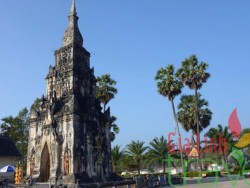Savannakhet
Savannakhet


Savannakhet

Savannakhet
Savanakhet is Laos’s third-largest city after Vientiane and Luang Phabang. The importance of this province lies in its strategic position for traveling from Thailand through Laos and on to Vietnam by Road No. 9, the highway servicing trade between Thailand and Vietnam.
Savannakhet also possesses very impressive architecture, including shophouses of ochre-colored stucco that are reminiscent of parts of Hanoi, which can make for a worthwhile couple of days’ stay.
Khanthabouly is the capital city of the province. Its main tourist attractions are the temples. These are among the most typical and beautiful in the country, especially That Inghang. The sanctuary of That Inghang holds special ceremonies in the third month of the year. Interesting Khmer ruins are found at Ban Heu Hin. Vat Saya Phoum is the most important temple in Savannakhet.
The Old City
Savannakhet’s town square was the heart of the French settlement, the surrounding neat grid streets reserved for the villas of French officials and the shophouses of Vietnamese merchants. One of the best areas for a stroll or spin on a bicycle to see old buildings is the district of tree-lined streets and former French administrative offices south of the post office. The old town also has several pleasant wats and a few Chinese temples worth a wander. Yet only a kilometer or two away from this bastion of French civilization, the paved roads became dirt paths meandering through traditional Lao villages that were largely unaffected by French rule and remain culturally pristine to this day.
The Old French Quarter boasts some fine examples of European-inspired architecture, though most of this looks much more ancient than it really is – it’s doubtful that any of these crumbling structures predate the early twentieth century. The main square is dominated by the octagonal spire of St Teresia Catholic Church, built in 1930, its thick masonry walls keeping the interior blessedly cool even on the hottest of days. Objects of interest include an old teakwood confessional and, high up on the walls, a set of hardwood plaques, with Vietnamese mother-of-pearl inlay, depicting the fourteen stations of the cross. Not surprisingly, the biblical characters have distinctly Asian faces: Christ resembles a Confucian sage, while the Roman soldiers look more like turban-wearing Mongols. On Saturday and Sunday mornings, Mass is said in Lao to an overwhelmingly ethnic-Vietnamese congregation. Just south of here, the Thai Consulate, housed in a 1926 mansion on Kouvolavong Road, is a fine example of how beautiful French-era buildings can be when properly restored.
Vietnamese and Chinese joss houses and schools in the area attest to the wealth and influence of Savannakhet’s merchant class. Gravitating towards urban areas and searching for business opportunities, the Chinese found their way to Savannakhet in small numbers before the arrival of the French. But the Vietnamese came for the most part at the encouragement of the French, who doubted the business acumen of ethnic Lao. After the revolution, most of Savannakhet’s ethnic Vietnamese and Chinese fled across the Mekong into Thailand, taking their capital and entrepreneurial skills with them. Even today, thirty years after the revolution, much of Savannakhet is empty of people, its shops shuttered, and packs of stray dogs roaming the streets. Only recently have the Chinese and Vietnamese started coming back in any numbers to invest, gradually reclaiming many of the old French-era shophouses and opening up a few businesses.
Attractions:
1. Wat Sainyaphum
Just north of the ferry landing, on the road running along the Mekong, sits Wat Sainyaphum, Savannakhet’s largest Buddhist monastery. Nearly all the structures at the wat, save for the school building in the northwest corner of the compound, have been recently restored in garish, circus-like hues. It is worth a visit, however, especially if you are looking for a serene, shady spot to catch up on your postcard-writing.
Around Savannakhet
A bicycle ride out in any direction from the centre of town gives you an opportunity to view the difference in lifestyles between the ethnic Vietnamese of the town and the ethnic Lao in the countryside. As you head out, brick and stucco give way to teak and bamboo, while rows of shade trees come to an abrupt halt and fruit trees – mango, guava and papaya – begin to appear in every yard. Children walking to and from school carry small cylindrical baskets, indicating a preference for sticky rice over steamed rice, and older Lao men favour a sarong in traditional shades of purple, orange and black over the shorts or trousers worn in urban areas. Depending on the season, rice fields are either being ploughed, planted, weeded or harvested by hand. The farmers are busiest in the hours just after dawn and before dusk, wisely spending the hottest time of the day snoozing in hammocks suspended in the shade.
Attractions:
1. That Ing Hang
A much revered Buddhist stupa dating from the sixteenth century, That Ing Hang is located just outside Savannakhet and can be reached by bicycle or motorcycle: follow Route 13 north for 13km until you see a sign on the right and follow this road for a further 3km. The stucco work that covers the stupa is crude yet appealing, especially the whimsical rosettes that dot the uppermost spire. Off to one side of the stupa stands an amusing sandstone sculpture of a lion, grinning like a Cheshire cat, which could only have been hauled here from one of the Khmer ruins downriver.
The stupa is best visited during its annual festival in February when thousands make the pilgrimage, camping in the walled courtyard that surrounds the stupa. During the celebrations, the door to a small chamber at the base of the stupa is opened, and male devotees queue up to make offerings to the Buddha images inside. By custom, women are prohibited from entering this inner sanctum.
